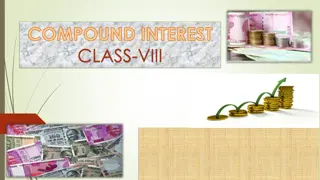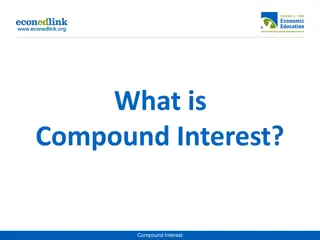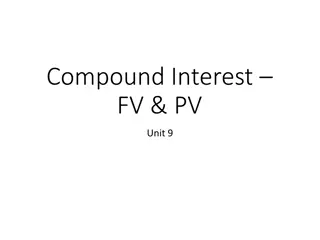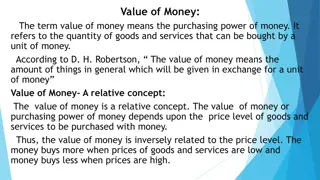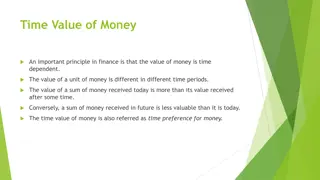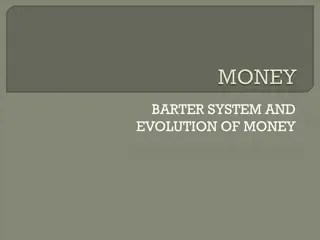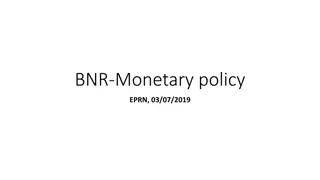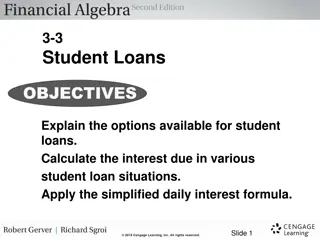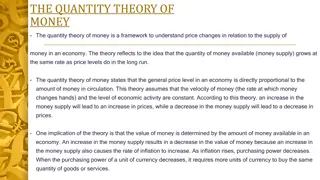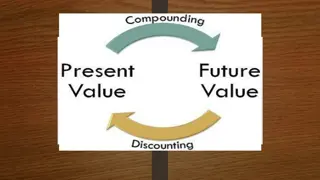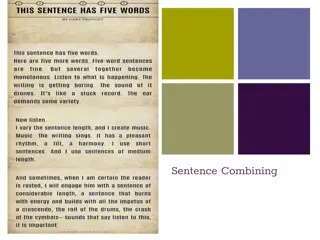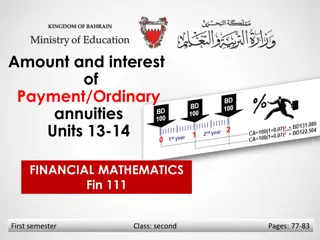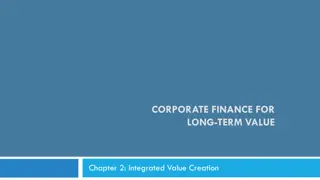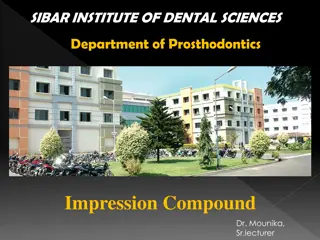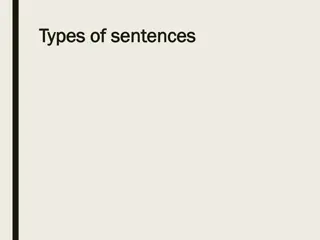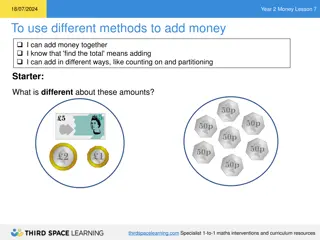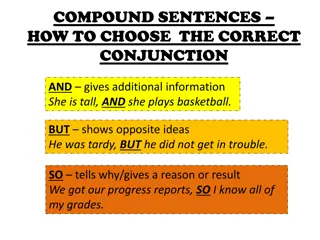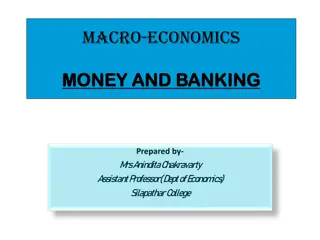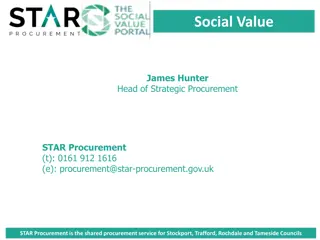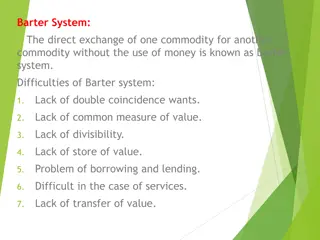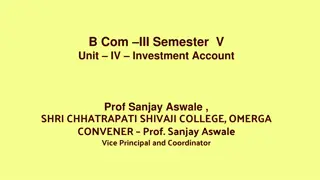Understanding the Time Value of Money: Simple vs Compound Interest
Explore the importance of time in financial decisions, the difference between simple and compound interest, and how it affects the future value of your investments. Learn about the formulas for simple interest, examples of its application, and the significance of compound interest for maximizing returns on your deposits.
Download Presentation

Please find below an Image/Link to download the presentation.
The content on the website is provided AS IS for your information and personal use only. It may not be sold, licensed, or shared on other websites without obtaining consent from the author. Download presentation by click this link. If you encounter any issues during the download, it is possible that the publisher has removed the file from their server.
E N D
Presentation Transcript
Chapter 3 Time Value of Money 3-1
The Time Value of Money The Interest Rate Simple Interest Compound Interest Amortizing a Loan 3-2
The Interest Rate Which would you prefer -- $10,000 today or $10,000 in 5 years? Obviously, $10,000 today. You already recognize that there is TIME VALUE TO MONEY!! 3-3
Why TIME? Why is TIME such an important element in your decision? TIME allows you the opportunity to postpone consumption and earn INTEREST. 3-4
Types of Interest Simple Interest Interest paid (earned) on only the original amount, or principal borrowed (lent). Compound Interest Interest paid (earned) on any previous interest earned, as well as on the principal borrowed (lent). 3-5
Simple Interest Formula Formula SI: Simple Interest P0: Deposit today (t=0) i: Interest Rate per Period n: Number of Time Periods SI = P0(i)(n) 3-6
Simple Interest Example Assume that you deposit $1,000 in an account earning 7% simple interest for 2 years. What is the accumulated interest at the end of the 2nd year? SI = P0(i)(n) = $1,000(.07)(2) = $140 3-7
Simple Interest (FV) What is the Future Value (FV) of the deposit? Future Value is the value at some future time of a present amount of money, or a series of payments, evaluated at a given interest rate. FV = P0 + SI = $1,000 + $140 = $1,140 3-8
Simple Interest (PV) What is the Present Value (PV) of the previous problem? The Present Value is simply the $1,000 you originally deposited. That is the value today! Present Value is the current value of a future amount of money, or a series of payments, evaluated at a given interest rate. 3-9
Why Compound Interest? Future Value of a Single $1,000 Deposit Future Value (U.S. Dollars) 20000 10% Simple Interest 7% Compound Interest 10% Compound Interest 15000 10000 5000 0 1st Year 10th 20th Year 30th Year Year 3-10
Future Value Single Deposit (Graphic) Assume that you deposit $1,000 at a compound interest rate of 7% for 2 years. 0 1 7% 2 $1,000 FV2 3-11
Future Value Single Deposit (Formula) FV1 = P0 (1+i)1 = $1,000 (1.07) = $1,070 Compound Interest You earned $70 interest on your $1,000 deposit over the first year. This is the same amount of interest you would earn under simple interest. 3-12
Future Value Single Deposit (Formula) FV1 = P0 (1+i)1 = $1,000 (1.07) = $1,070 FV2 = FV1 (1+i)1 = P0 (1+i)(1+i) = $1,000(1.07)(1.07) = P0 (1+i)2 = $1,000(1.07)2 = $1,144.90 You earned an EXTRA$4.90 in Year 2 with compound over simple interest. 3-13
General Future Value Formula FV1 = P0(1+i)1 FV2 = P0(1+i)2 etc. General Future Value Formula: FVn = P0 (1+i)n or FVn = P0 (FVIFi,n) -- See Table I 3-14
Valuation Using Table I FVIFi,n is found on Table I at the end of the book or on the card insert. Period 1 2 3 4 5 6% 1.060 1.124 1.191 1.262 1.338 7% 1.070 1.145 1.225 1.311 1.403 8% 1.080 1.166 1.260 1.360 1.469 3-15
Using Future Value Tables FV2 Period 1 2 3 4 5 = $1,000 (FVIF7%,2) = $1,000 (1.145) = $1,145 [Due to Rounding] 6% 1.060 1.070 1.124 1.145 1.191 1.225 1.262 1.311 1.338 1.403 7% 8% 1.080 1.166 1.260 1.360 1.469 3-16
Story Problem Example Julie Miller wants to know how large her deposit of $10,000 today will become at a compound annual interest rate of 10% for 5 years. 0 1 2 3 4 5 10% $10,000 FV5 3-17
Story Problem Solution Calculation based on general formula: FVn = P0 (1+i)n FV5= $10,000 (1+ 0.10)5 = $16,105.10 Calculation based on Table I: FV5= $10,000 (FVIF10%, 5) = $10,000 (1.611) = $16,110 [Due to Rounding] 3-18
Double Your Money!!! Quick! How long does it take to double $5,000 at a compound rate of 12% per year (approx.)? We will use the Rule-of-72 . 3-19
The Rule-of-72 Quick! How long does it take to double $5,000 at a compound rate of 12% per year (approx.)? Approx. Years to Double = 72 / i% 72 / 12% = 6 Years [Actual Time is 6.12 Years] 3-20
Present Value Single Deposit (Graphic) Assume that you need $1,000 in 2 years. Let s examine the process to determine how much you need to deposit today at a discount rate of 7% compounded annually. 0 1 7% 2 $1,000 PV0 PV1 3-21
Present Value Single Deposit (Formula) PV0 = FV2 / (1+i)2 = FV2 / (1+i)2 = $1,000 / (1.07)2 = $873.44 0 1 7% 2 $1,000 PV0 3-22
General Present Value Formula PV0 = FV1 / (1+i)1 PV0 = FV2 / (1+i)2 etc. General Present Value Formula: PV0 = FVn / (1+i)n or PV0 = FVn (PVIFi,n) -- See Table II 3-23
Valuation Using Table II PVIFi,n is found on Table II at the end of the book or on the card insert. Period 1 2 3 4 5 6% .943 .890 .840 .792 .747 7% .935 .873 .816 .763 .713 8% .926 .857 .794 .735 .681 3-24
Using Present Value Tables PV2 Period 1 2 3 4 5 = $1,000 (PVIF7%,2) = $1,000 (.873) = $873 [Due to Rounding] 6% .943 .890 .840 .792 .747 7% .935 .873 .816 .763 .713 8% .926 .857 .794 .735 .681 3-25
Story Problem Example Julie Miller wants to know how large of a deposit to make so that the money will grow to $10,000 in 5 years at a discount rate of 10%. 0 1 2 3 4 5 10% $10,000 PV0 3-26
Story Problem Solution Calculation based on general formula: PV0 = FVn / (1+i)n PV0= $10,000 / (1+ 0.10)5 = $6,209.21 Calculation based on Table I: PV0= $10,000 (PVIF10%, 5) = $10,000 (.621) = $6,210.00 [Due to Rounding] 3-27
Types of Annuities An Annuity represents a series of equal payments (or receipts) occurring over a specified number of equidistant periods. Ordinary Annuity: Payments or receipts occur at the end of each period. Annuity Due: Payments or receipts occur at the beginning of each period. 3-28
Examples of Annuities Student Loan Payments Car Loan Payments Insurance Premiums Mortgage Payments Retirement Savings 3-29
Parts of an Annuity (Ordinary Annuity) End of Period 1 End of Period 2 End of Period 3 0 1 2 3 $100 $100 $100 Equal Cash Flows Each 1 Period Apart Today 3-30
Parts of an Annuity (Annuity Due) Beginning of Period 1 Beginning of Period 2 Beginning of Period 3 0 1 2 3 $100 $100 $100 Equal Cash Flows Each 1 Period Apart Today 3-31
Overview of an Ordinary Annuity -- FVA Cash flows occur at the end of the period 0 1 2 n n+1 i% . . . R R R R= Periodic Cash Flow FVAn FVAn = R(1+i)n-1 + R(1+i)n-2 + ... + R(1+i)1 + R(1+i)0 3-32
Example of an Ordinary Annuity -- FVA Cash flows occur at the end of the period 0 1 2 3 4 7% $1,000 $1,000 $1,000 $1,070 $1,145 FVA3 = $1,000(1.07)2 + $1,000(1.07)1 + $1,000(1.07)0 $3,215 = FVA3 = $1,145 + $1,070 + $1,000 = $3,215 3-33
Hint on Annuity Valuation The future value of an ordinary annuity can be viewed as occurring at the end of the last cash flow period, whereas the future value of an annuity due can be viewed as occurring at the beginning of the last cash flow period. 3-34
Valuation Using Table III FVAn = R (FVIFAi%,n) FVA3 = $1,000 (FVIFA7%,3) = $1,000 (3.215) = $3,215 Period 6% 1 1.000 2 2.060 3 3.184 4 4.375 5 5.637 7% 1.000 2.070 3.215 4.440 5.751 8% 1.000 2.080 3.246 4.506 5.867 3-35
Overview of an Annuity Due -- FVAD Cash flows occur at the beginning of the period 0 1 2 3 n-1 n i% . . . R R R R R FVADn = R(1+i)n + R(1+i)n-1 + ... + R(1+i)2 + R(1+i)1 = FVAn (1+i) FVADn 3-36
Example of an Annuity Due -- FVAD Cash flows occur at the beginning of the period 0 1 2 3 4 7% $1,000 $1,000 $1,000 $1,070 $1,145 $1,225 FVAD3 = $1,000(1.07)3 + $1,000(1.07)2 + $1,000(1.07)1 $3,440 = FVAD3 = $1,225 + $1,145 + $1,070 = $3,440 3-37
Valuation Using Table III FVADn FVAD3 Period = R (FVIFAi%,n)(1+i) = $1,000 (FVIFA7%,3)(1.07) = $1,000 (3.215)(1.07) = $3,440 6% 7% 1.000 1.000 2.060 2.070 3.184 3.215 4.375 4.440 5.637 5.751 8% 1.000 2.080 3.246 4.506 5.867 1 2 3 4 5 3-38
Overview of an Ordinary Annuity -- PVA Cash flows occur at the end of the period 0 1 2 n n+1 i% . . . R R R R= Periodic Cash Flow PVAn PVAn = R/(1+i)1 + R/(1+i)2 + ... + R/(1+i)n 3-39
Example of an Ordinary Annuity -- PVA Cash flows occur at the end of the period 0 1 2 3 4 7% $1,000 $1,000 $1,000 $ 934.58 $ 873.44 $ 816.30 PVA3 = $1,000/(1.07)1 + $1,000/(1.07)2 + $1,000/(1.07)3 $2,624.32 = PVA3 = $934.58 + $873.44 + $816.30 = $2,624.32 3-40
Hint on Annuity Valuation The present value of an ordinary annuity can be viewed as occurring at the beginning of the first cash flow period, whereas the present value of an annuity due can be viewed as occurring at the end of the first cash flow period. 3-41
Valuation Using Table IV PVAn = R (PVIFAi%,n) PVA3 = $1,000 (PVIFA7%,3) = $1,000 (2.624) = $2,624 Period 6% 1 0.943 2 1.833 3 2.673 4 3.465 5 4.212 7% 0.935 1.808 2.624 3.387 4.100 8% 0.926 1.783 2.577 3.312 3.993 3-42
Overview of an Annuity Due -- PVAD Cash flows occur at the beginning of the period 0 1 2 n-1 n i% . . . R R R R R: Periodic Cash Flow PVADn PVADn = R/(1+i)0 + R/(1+i)1 + ... + R/(1+i)n-1 = PVAn (1+i) 3-43
Example of an Annuity Due -- PVAD Cash flows occur at the beginning of the period 0 1 2 3 4 7% $1,000.00 $1,000 $1,000 $ 934.58 $ 873.44 $2,808.02 = PVADn PVADn = $1,000/(1.07)0 + $1,000/(1.07)1 + $1,000/(1.07)2 = $2,808.02 3-44
Valuation Using Table IV PVADn = R (PVIFAi%,n)(1+i) PVAD3 = $1,000 (PVIFA7%,3)(1.07) = $1,000 (2.624)(1.07) = $2,808 Period 6% 1 0.943 2 1.833 3 2.673 4 3.465 5 4.212 7% 0.935 1.808 2.624 3.387 4.100 8% 0.926 1.783 2.577 3.312 3.993 3-45
Steps to Solve Time Value of Money Problems 1. Read problem thoroughly 2. Determine if it is a PV or FV problem 3. Create a time line 4. Put cash flows and arrows on time line 5. Determine if solution involves a single CF, annuity stream(s), or mixed flow 6. Solve the problem 7. Check with financial calculator (optional) 3-46
Mixed Flows Example Julie Miller will receive the set of cash flows below. What is the Present Value at a discount rate of 10%? 0 1 2 3 4 5 10% $600 $600 $400 $400 $100 PV0 3-47
How to Solve? 1. Solve a piece-at-a-time by discounting each piece back to t=0. 2. Solve a group-at-a-time by first breaking problem into groups of annuity streams and any single cash flow group. Then discount each group back to t=0. 3-48
Piece-At-A-Time 0 1 2 3 4 5 10% $600 $600 $400 $400 $100 $545.45 $495.87 $300.53 $273.21 $ 62.09 $1677.15 = PV0 of the Mixed Flow 3-49
Group-At-A-Time (#1) 0 1 2 3 4 5 10% $600 $600 $400 $400 $100 $1,041.60 $ 573.57 $ 62.10 $1,677.27 = PV0 of Mixed Flow [Using Tables] $600(PVIFA10%,2) = $600(1.736) = $1,041.60 $400(PVIFA10%,2)(PVIF10%,2) = $400(1.736)(0.826) = $573.57 $100 (PVIF10%,5) = $100 (0.621) = $62.10 3-50


